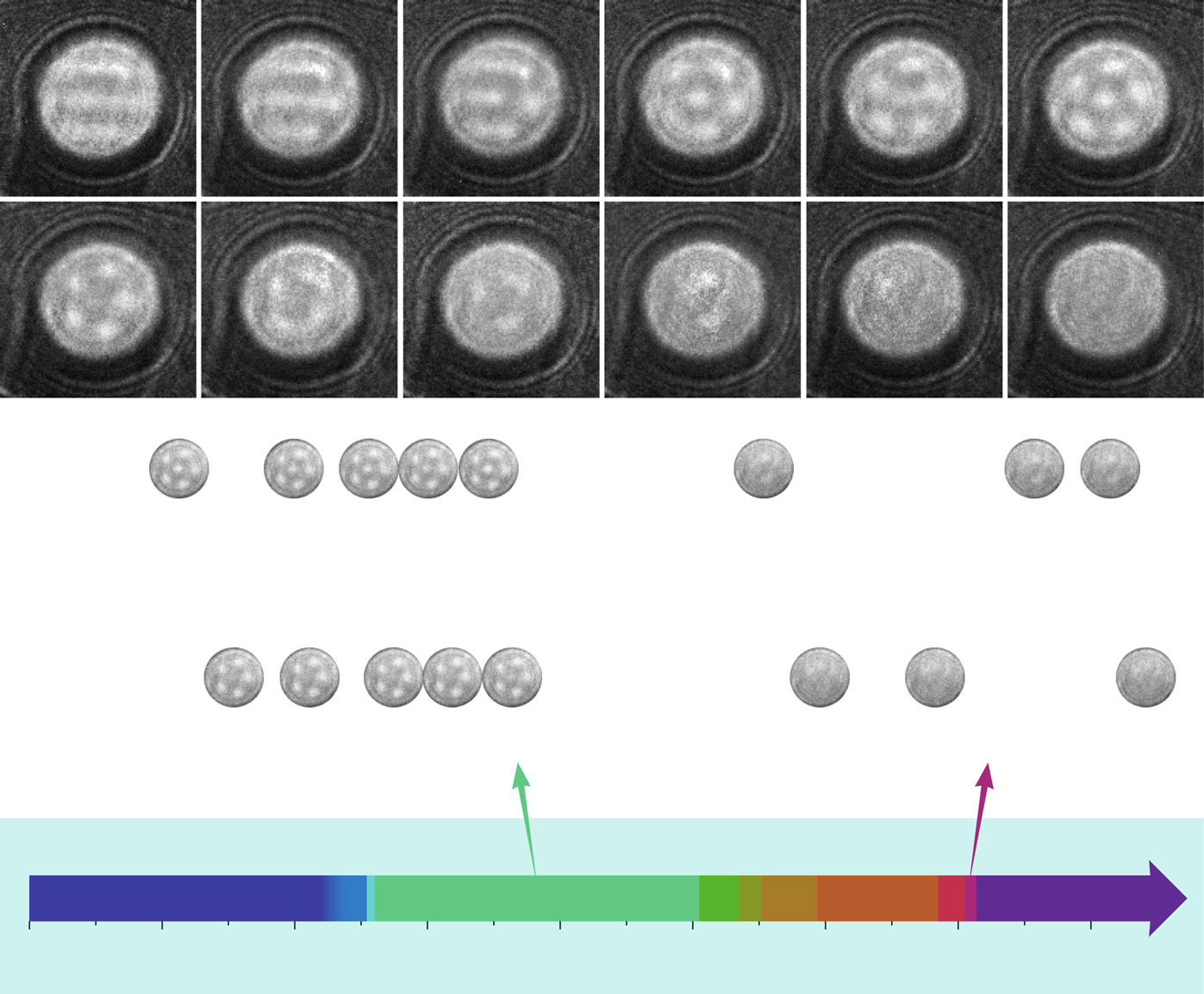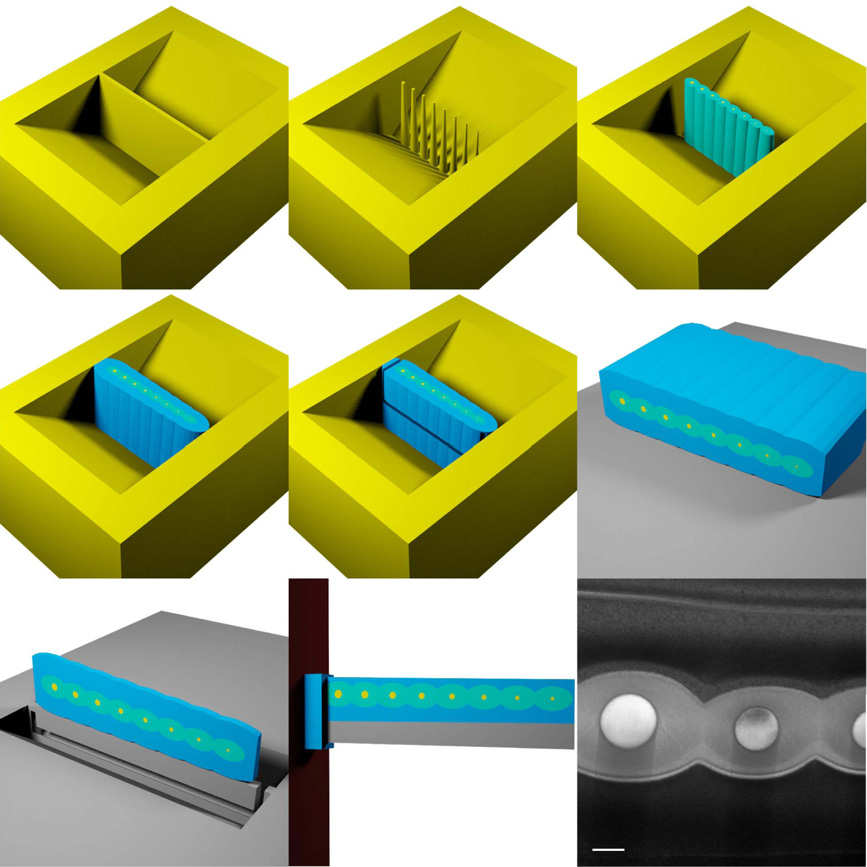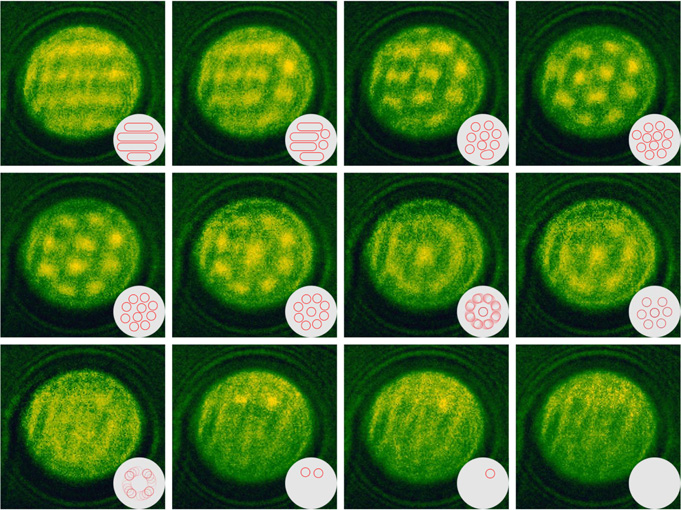

Prof. Mingliang Tian (Chinese Academy of Science) and Prof. Renchao Che (Fudan University) discussed the paper that they and their colleagues published in Proceedings of the National Academy of Sciences. One of the main challenges the team encountered, Tian tells Phys.org, was demonstrating the direct visualization of skyrmion cluster states of in nanodisks fabricated from iron-germanium. The scientists accomplished this, he adds, by using high-resolution Lorentz transmission electron microscopy to report the magnetic field-driven dynamics of individual skyrmions in nanodisks with diameters on the order of several skyrmions. "Real-space imaging of skyrmions is essential for addressing the dynamic behaviors of individual skyrmions," he explains. "However, the real implementation is highly challenging because of limitations in spatial resolution, sensitivity and the edge effect of the nanostructure on the recorded contrast of Lorentz transmission electron microscopy." Lorentz transmission electron microscopy (LTEM) is used to study a material's magnetic domains by imaging the deflection of electrons caused by the Lorentz force in magnetic fields. "The latter issue seriously affects the visualization of individual skyrmions in nanostructures with sizes below 200 nm due to the presence of Fresnel fringes, formed at the edge of the nanostructure," adds Prof. Renchao Che, director of Fudan University's LTEM lab. "This is because LTEM imaging requires an out-of-focus condition that causes the Fresnel fringes to smear out the recorded magnetic signal in the vacuum/sample interface."
As described in the paper, Tian's team members and co-authors, Dr. Haifeng Du and doctoral student Chiming Jin, developed a technique to reduce the interfacial Fresnel fringes in the Lorentz TEM images by using a focused ion beam (FIB) to encircle the outer size-tunable nanodisks with a layer of amorphous platinum-carbon alloy (PtCx). "This significantly reduced the size range of the artificial magnetic contrast," Tian explains, "thus leading to the direct image of the skyrmion cluster states in 100 nm scale disks."

While LTEM is a powerful tool for imaging magnetic structures with nanometer-scale resolution, and has been used to image skyrmions by Dr. Xiuzhen Yu1, Tian notes that direct imaging of individual skyrmions in nanodisks with a size on the order of ~ 100 nm is still challenging due to the influence of Fresnel fringes at the sample edge. "By utilizing a top-to-down method with FIB technique, we fabricated nanodisks of various diameters from bulk FeGe enclosed with amorphous PtCx composite in order to enhance the mechanical strength and thereby precise manipulation of the nanodisk. "We're very lucky that edge coating with conducting PtCx composites was found to greatly weaken the Fresnel fringes near the edge boundary, and that by so doing enables us to extract the magnetic information in nanodisks smaller than 180 nm."
The scientists state that the team's results have immediate implication for designing future skyrmion-based devices, such as multibit memory cells. "We give the direct proof that single skyrmion can exist in nanostructured elements," Tian says. "Given the similarity between the skyrmions and magnetic vortices in soft magnetic nanodisks, the observed individual skyrmions will provide a viable alternative to spin-torque vortex-oscillator devices, and be a potential candidates for microwave signal-processing applications."

Fig. S1. Schematic procedure for fabricating FeGe nanodisks by using the FIB-SEM dual-beam system (Helios NanoLab 600i; FEI) equipped with a GIS, and Omniprobe 200+ micromanipulator. The whole process is shown schematically in eight steps for A–I: (A) Following the standard TEM specimen preparation procedure (40), a thin FeGe sheet with a thickness of ~1 μm was carved on the surface of a polycrystalline FeGe bulk using the FIB milling technique. (B) The FeGe sheet was cut into circular columns with different diameters by FIB using annular patterns. (C) Using the GIS system, a layer of amorphous PtCx was deposited on the FeGe columns by the electron beam-assisted chemical vapor deposition technique. This PtCx coating works as protection of the FeGe nanocolumns for nanomanipulation processes and also reduces the Fresnel fringe at the edge of the disk for the Lorentz TEM study. (D) Further deposition of amorphous PtCx layer by ion beam-assisted chemical vapor deposition to fasten the samples. (E) A U-shaped cut was made from the sheet by FIB milling. (F) The sheet of FeGe nanocolumns surrounded by amorphous PtCx was transferred to a clean surface of silicon and laid down by an Omniprobe 200+ micromanipulator. (G) Using the standard TEM specimen preparation procedure, a slice consisting of FeGe nanodisks in various sizes was fabricated by FIB milling. (H) The slice was transferred to a TEM Cu chip using the micromanipulator, and then was thinned to the desired thickness. (I) TEM image of the nanodisk sample depicted in the dashed box in H. (Scale bar, 200 nm.) Credit: Xuebing Zhao, et al. (2016) Direct imaging of magnetic field-driven transitions of skyrmion cluster states in FeGe nanodisks. Proc Natl Acad Sci USA 113 (18) 4918-4923.
The paper points out that the theory-predicted target skyrmion in chiral magnets was not observed in the present experiment due to weak magnetic contrast and Fresnel fringes. "Target skyrmions, a concentric helicoidal undulation predicted previously by Dr. Du, may spontaneously exist in small size nanodisks without an external magnetic field, which is more suitable to skyrmion-based devices," Tian tells Phys.org. "It shows that target skyrmion stability will increase as nanodisk size decreases. However, at sizes below 100 nm, the weak artificial contrast from the edge will diffuse the real magnetic structure though the PtCx coating, and so significantly reduce the edge effect. Therefore, to realize the observation of target skyrmions, other magnetic microscopy techniques such as electron holography should be considered to avoid Fresnel fringe interference."
Moving forward, says Tian, by cooperative research between his nanomagnet physical properties team and Che's structural characterization team, the researchers will target several important issues in future, including searching for target skyrmions by varying disk size, thickness or other conditions by using electron holography, as previously noted; studying the current-driven motion of skyrmions in confined geometries; performing manipulation and electrical detection of skyrmions; and developing new techniques to fabricate nano-sized samples that are more controllable and more efficient for large-scale production.
In closing, Tian tells Phys.org that other areas of might research benefit from their study. "The techniques used in our study, such as our focused ion beam patterned procedure and transport intensity equation analysis, can be applied to other micromagnetics research. Moreover, since skyrmions have many features in common with Abrikosov vortices in superconductors, our results may provide some inspirations in this field." (Phys.org)

Fig. S2. Underfocused Lorentz TEM images of a 330-nm FeGe nanodisk at 220 K under an external magnetic field. At zero field, the ground state consists of four helical periods. With the increase of the external field, some skyrmions were nucleated from the helix at 0.45 kOe, and the skyrmions eventually occupied the whole disk at 0.47 kOe. After the number of skyrmions Ns reaches the maximum of 11, i.e., eight skyrmions circle around the edge of the disk, with three inside the circle. Further increasing the external field, the number of the inner skyrmions, in turn, merges to 2 at 0.81 kOe and 1 at 0.98 kOe. It’s worth noting that, at 0.98 kOe, the eight circumambient skyrmions begin to rotate around the center one, leading to a ring-like structure (see Movie S3). Red circles in the white plate at the corner of each panel point out the position of skyrmions and helixes. All images are extracted from a video captured at a defocus value of ?288 μm and an exposure time of 0.2 s. Credit: Xuebing Zhao, et al. (2016) Direct imaging of magnetic field-driven transitions of skyrmion cluster states in FeGe nanodisks. Proc Natl Acad Sci USA 113 (18) 4918-4923.
A video captured in Lorentz TEM showing that the eight circumambient skyrmions begin to rotate around the center one, as soon as the two skyrmions in the center merged into one, in a 330-nm FeGe nanodisk at 0.98 kOe, T = 220 K. The defocus value is ?288 μm. Credit: Xuebing Zhao, et al. (2016) Direct imaging of magnetic field-driven transitions of skyrmion cluster states in FeGe nanodisks. Proc Natl Acad Sci USA 113 (18) 4918-4923.

86-10-68597521 (day)
86-10-68597289 (night)

52 Sanlihe Rd., Xicheng District,
Beijing, China (100864)

